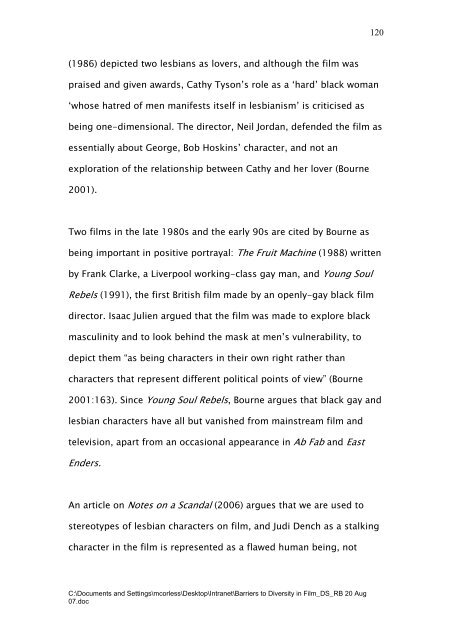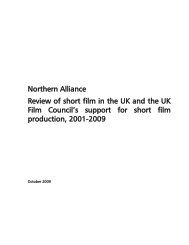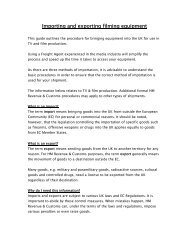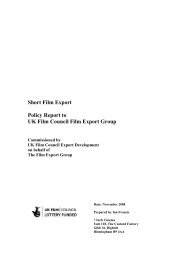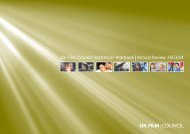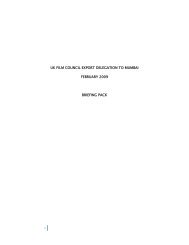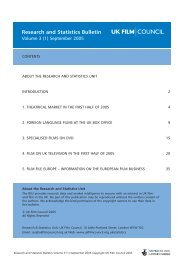Barriers to Diversity in Film – A Research Review – Aug 07
Barriers to Diversity in Film – A Research Review – Aug 07
Barriers to Diversity in Film – A Research Review – Aug 07
Create successful ePaper yourself
Turn your PDF publications into a flip-book with our unique Google optimized e-Paper software.
(1986) depicted two lesbians as lovers, and although the film was<br />
praised and given awards, Cathy Tyson’s role as a ‘hard’ black woman<br />
‘whose hatred of men manifests itself <strong>in</strong> lesbianism’ is criticised as<br />
be<strong>in</strong>g one-dimensional. The direc<strong>to</strong>r, Neil Jordan, defended the film as<br />
essentially about George, Bob Hosk<strong>in</strong>s’ character, and not an<br />
exploration of the relationship between Cathy and her lover (Bourne<br />
2001).<br />
Two films <strong>in</strong> the late 1980s and the early 90s are cited by Bourne as<br />
be<strong>in</strong>g important <strong>in</strong> positive portrayal: The Fruit Mach<strong>in</strong>e (1988) written<br />
by Frank Clarke, a Liverpool work<strong>in</strong>g-class gay man, and Young Soul<br />
Rebels (1991), the first British film made by an openly-gay black film<br />
direc<strong>to</strong>r. Isaac Julien argued that the film was made <strong>to</strong> explore black<br />
mascul<strong>in</strong>ity and <strong>to</strong> look beh<strong>in</strong>d the mask at men’s vulnerability, <strong>to</strong><br />
depict them “as be<strong>in</strong>g characters <strong>in</strong> their own right rather than<br />
characters that represent different political po<strong>in</strong>ts of view” (Bourne<br />
2001:163). S<strong>in</strong>ce Young Soul Rebels, Bourne argues that black gay and<br />
lesbian characters have all but vanished from ma<strong>in</strong>stream film and<br />
television, apart from an occasional appearance <strong>in</strong> Ab Fab and East<br />
Enders.<br />
An article on Notes on a Scandal (2006) argues that we are used <strong>to</strong><br />
stereotypes of lesbian characters on film, and Judi Dench as a stalk<strong>in</strong>g<br />
character <strong>in</strong> the film is represented as a flawed human be<strong>in</strong>g, not<br />
C:\Documents and Sett<strong>in</strong>gs\mcorless\Desk<strong>to</strong>p\Intranet\<strong>Barriers</strong> <strong>to</strong> <strong>Diversity</strong> <strong>in</strong> <strong>Film</strong>_DS_RB 20 <strong>Aug</strong><br />
<strong>07</strong>.doc<br />
120


